Good decisions come from experience and experience comes from bad decisions. That was a standout line I read while having the breakfast recently and I think it’s a fair assessment too.
A consequence of some of that experience earned is it’s been learned the hard way.
In late June, with feed bursting out of the ground and silage well on target, a decision was made to hold off on cutting more surplus silage until the next rainfall.
Breeding was well under control and if there was no rain then the strip wires would come into play and heavy covers would be fed as standing fodder. The other option was to make more silage and run the risk of feeding it out if rain didn’t arrive for a few weeks as happened before. Sure enough rain decided to wait until Sunday morning last and the bales in the yard remained untouched.
The recent dry spell played out very similarly to 2006 where we had no rain here for nine weeks from late July to mid-September. We had only started farming the full block of ground here in 2005 as when my parents inherited it, half of the farm was in a long-term lease, so we hadn’t a full handle on the form of the place.

Established multispecies swards meant no silage had to be fed to cows despite the dry spell on Tommy Moyles' farm.
Stock numbers were lower then but as we got the lay of the land and learned how close rock was to the surface in places and which slope dried, we figured it was safer to ensure there was always bales left over in the event of the annual dry spell which subsequently arrived most summers.
The noted exception was 2012, but even then we had to feed bales that summer as some stock were housed as land was saturated. Every year from then on bales were required at some point from May through August. This year is the exception.
Out of curiosity, I dug out the 2006 diary from the filing cabinet and it threw up a few interesting bits. I had more fertiliser spread by 4 April than I have for this year. What I spread across the entire farm this year is just over 10% of what I spread on all owned ground back then. That was when we had a lower stocking rate too. I had one field listed as “Serengeti” in my diary and while the name didn’t stick, that field dried up like it did 16 years ago.
Rain arrived here over the weekend and there are green shoots appearing again. With some younger cows coming home this week, silage is likely to go in the diet of the cull cows in an effort to reduce grazing demand and allow covers to build up.
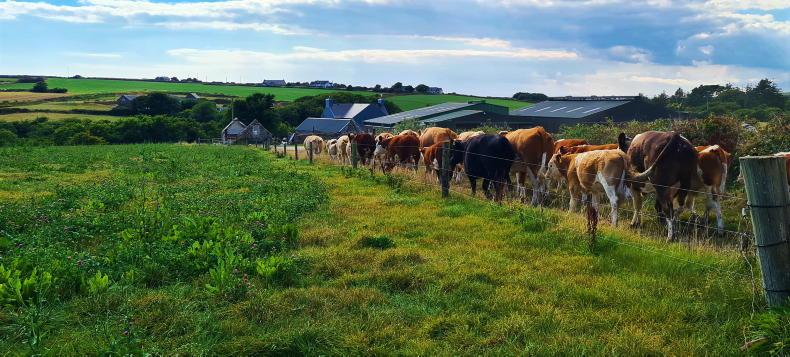
Cows and calves head to the yard for weighing on Tommy Moyles farm at Ardfield, Clonakilty, Co Cork.
This dry spell was a good test of the multispecies swards, that’s for sure. Initially experimented with following the 2018 drought, they’re likely to be in some form across all the owned land within 12 months.
Despite receiving no significant rainfall for the last six or seven weeks and no artificial fertiliser all year, they kept ticking along. They were cost savers too, receiving no fertiliser.
At this year’s fertiliser prices, I’ve saved over €7,000 compared to the 2021 fertiliser bill and €25,000 if I was still using the same amount as 2012.
Multispecies aren’t everybody’s cup of tea but it’s a case of so far so good here.
Good decisions come from experience and experience comes from bad decisions. That was a standout line I read while having the breakfast recently and I think it’s a fair assessment too.
A consequence of some of that experience earned is it’s been learned the hard way.
In late June, with feed bursting out of the ground and silage well on target, a decision was made to hold off on cutting more surplus silage until the next rainfall.
Breeding was well under control and if there was no rain then the strip wires would come into play and heavy covers would be fed as standing fodder. The other option was to make more silage and run the risk of feeding it out if rain didn’t arrive for a few weeks as happened before. Sure enough rain decided to wait until Sunday morning last and the bales in the yard remained untouched.
The recent dry spell played out very similarly to 2006 where we had no rain here for nine weeks from late July to mid-September. We had only started farming the full block of ground here in 2005 as when my parents inherited it, half of the farm was in a long-term lease, so we hadn’t a full handle on the form of the place.

Established multispecies swards meant no silage had to be fed to cows despite the dry spell on Tommy Moyles' farm.
Stock numbers were lower then but as we got the lay of the land and learned how close rock was to the surface in places and which slope dried, we figured it was safer to ensure there was always bales left over in the event of the annual dry spell which subsequently arrived most summers.
The noted exception was 2012, but even then we had to feed bales that summer as some stock were housed as land was saturated. Every year from then on bales were required at some point from May through August. This year is the exception.
Out of curiosity, I dug out the 2006 diary from the filing cabinet and it threw up a few interesting bits. I had more fertiliser spread by 4 April than I have for this year. What I spread across the entire farm this year is just over 10% of what I spread on all owned ground back then. That was when we had a lower stocking rate too. I had one field listed as “Serengeti” in my diary and while the name didn’t stick, that field dried up like it did 16 years ago.
Rain arrived here over the weekend and there are green shoots appearing again. With some younger cows coming home this week, silage is likely to go in the diet of the cull cows in an effort to reduce grazing demand and allow covers to build up.

Cows and calves head to the yard for weighing on Tommy Moyles farm at Ardfield, Clonakilty, Co Cork.
This dry spell was a good test of the multispecies swards, that’s for sure. Initially experimented with following the 2018 drought, they’re likely to be in some form across all the owned land within 12 months.
Despite receiving no significant rainfall for the last six or seven weeks and no artificial fertiliser all year, they kept ticking along. They were cost savers too, receiving no fertiliser.
At this year’s fertiliser prices, I’ve saved over €7,000 compared to the 2021 fertiliser bill and €25,000 if I was still using the same amount as 2012.
Multispecies aren’t everybody’s cup of tea but it’s a case of so far so good here.






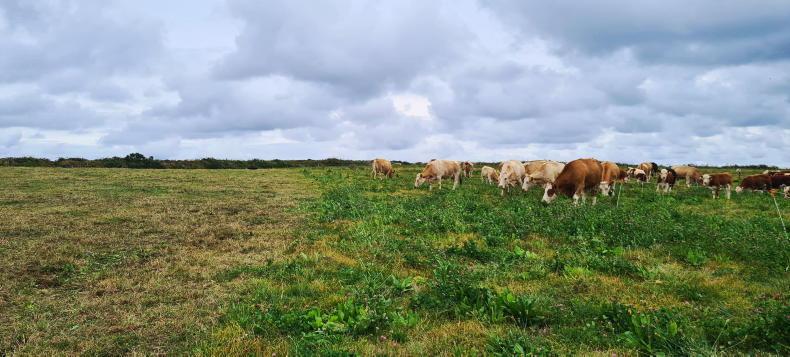
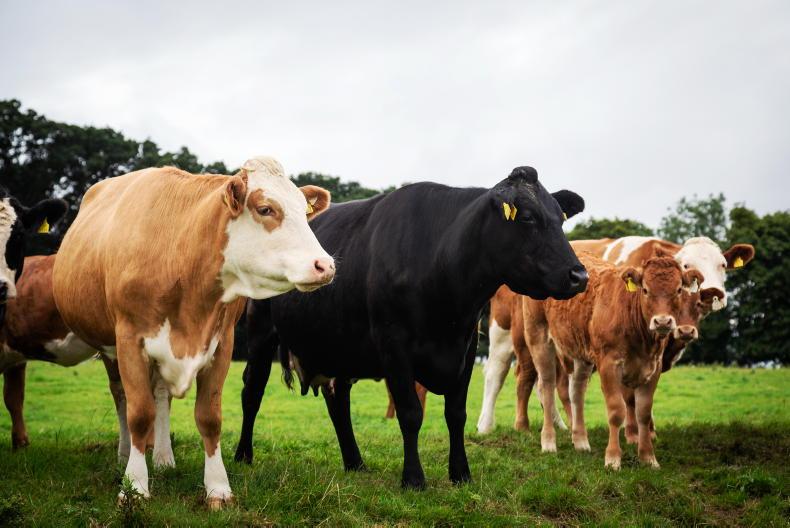

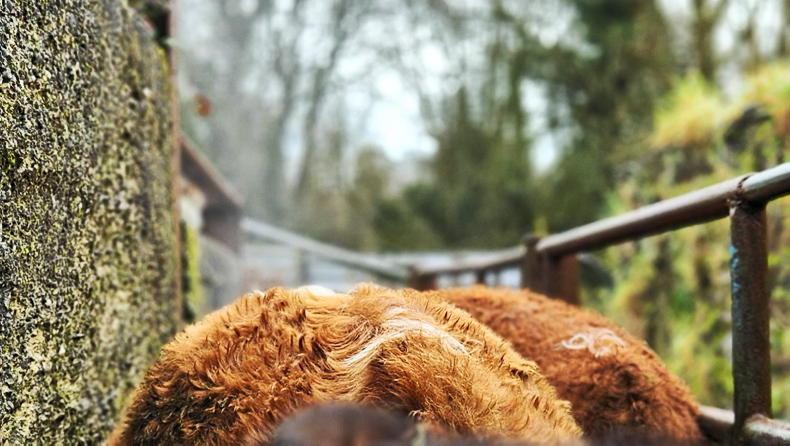
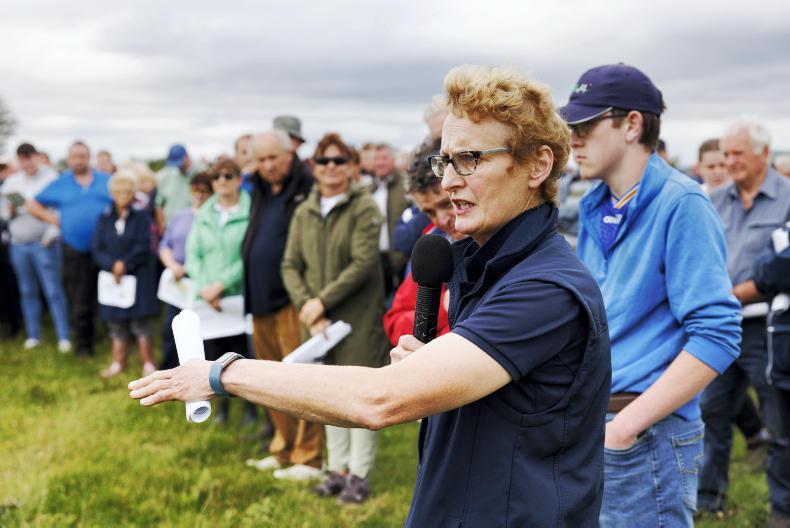

SHARING OPTIONS